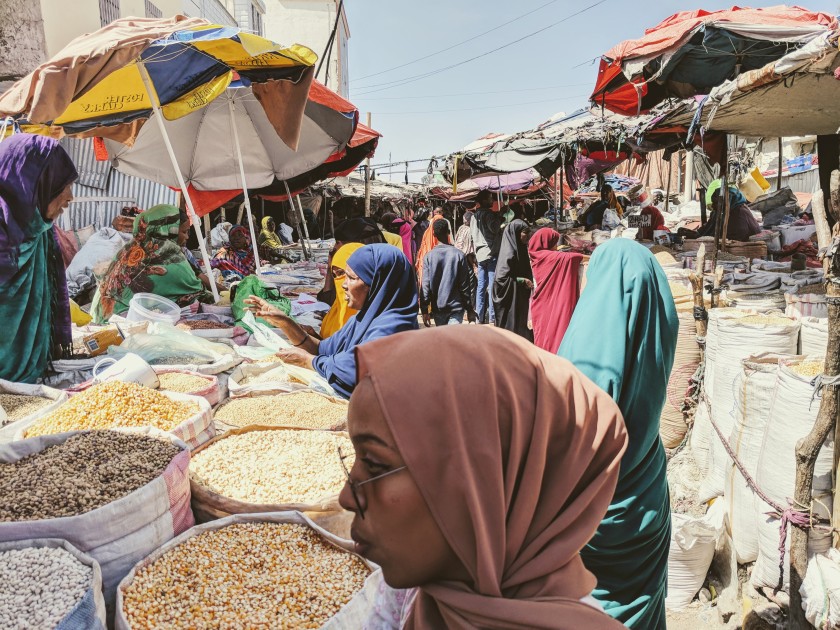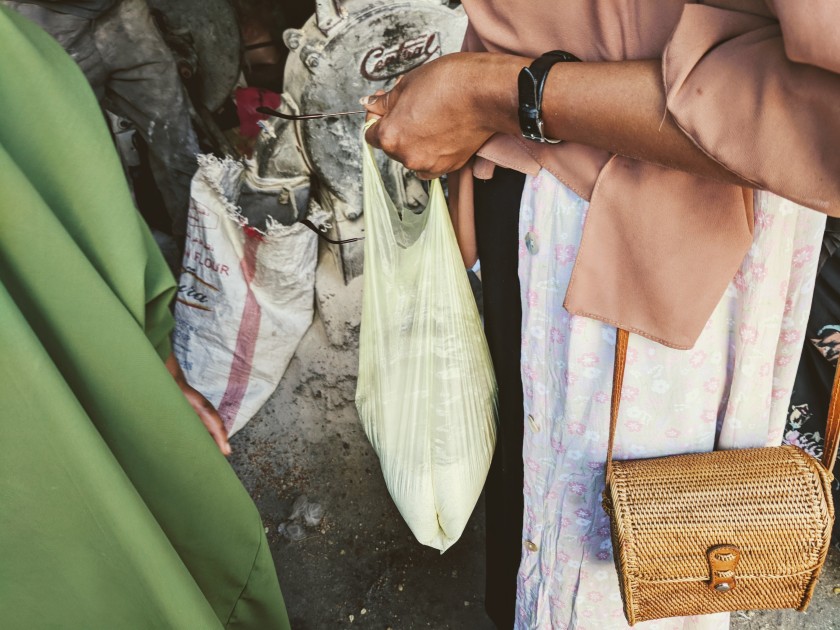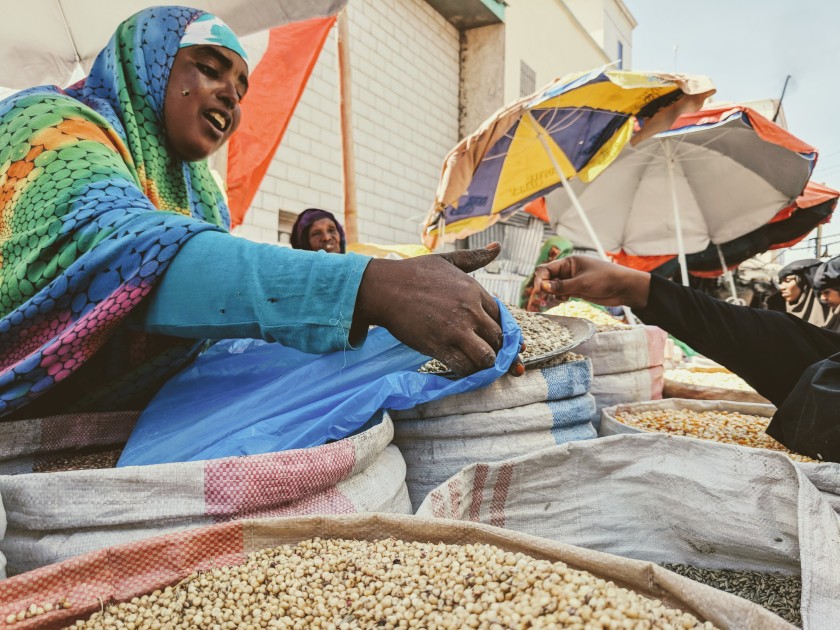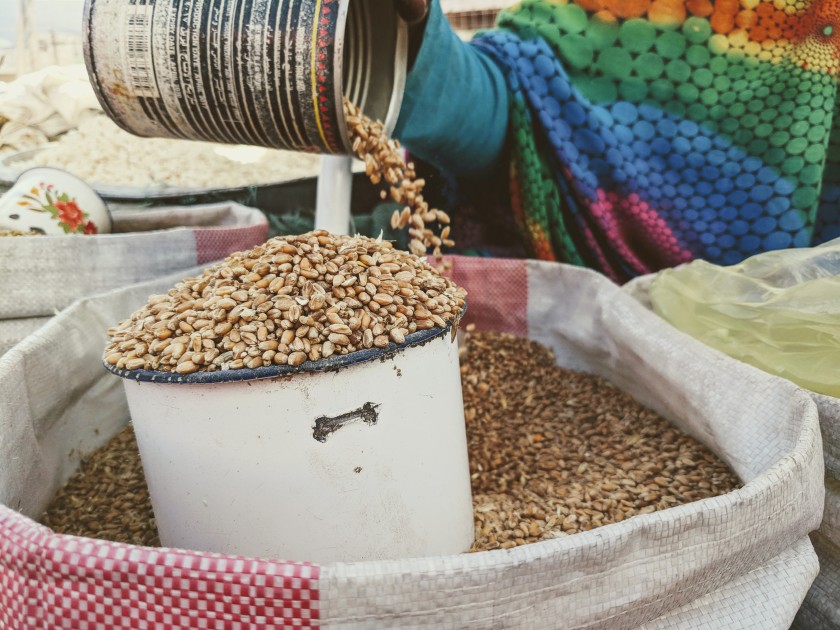I’ve lived in Hargeisa for nearly three years, and learned a lot through trial and error and… more error. I can get around pretty well on my own, including at the market, diving in, finding what I need, negotiating a bit, and jumping back out.

But there’s one section of the market I haven’t been able to wrap my mind around: Grain Alley. (This is a totally fabricated name that I established to reflect how intimidated I am by this place. It works, yes? Like a Somali Diagon Alley, but more souk-esque). Grain Alley is lined on either side with giant sacks of legumes, cereals, and other dried goods. Vendors, all women dressed in colorful jilbab or wrapped in patterned scarves, sit perched atop their mountainous spreads, each sack not much farther than arms length.

If you know what you’re looking for, there’s a logic to Grain Alley: You find your preferred vendor, ask for a cupful of this, maybe mixed with a cupful of that, haul it over to the miller if you want it ground, and make out with a few kilos of cereals for as many dollars.

Here’s my issue: I can’t identify what’s in the sacks. With the exception of corn and lentils, everything else is a mystery. That kinda looks like wheat or… barley or… farro? Every time I go, I scratch my head and hightail it before I make a fool of myself.


I’ve tried different methods to figure this out: I’ve taken close-up photos and searched Google images, but there are multiple colors/varieties of most of the grains, and things look different hulled or not hulled… I don’t get any closer to answers.

I can’t find anyone who knows the names in both English and Somali and the kicker is that Google translate, for example, usually skews towards the South-Central Somali dialect, which is a bit different from here up north. Plus, names for some of these differ a few hundred kilometers in either direction. This all means that Google-assisted research has been fruitless so far.

The few times I thought I put my finger on a translation—sarreen, for example, which I thought was barley—it slips away when I find someone else who translates it differently (a friend down the road thinks it’s farro, another says it simply means wheat).

This morning I asked a friend to accompany me to Grain Alley to sort things out once and for all: she speaks Somali, Arabic, and English fluently. But when we arrived, she was stumped as well, and disagreed with the vendor about the Somali name of a few items!

So, I’m reaching out, friends. Anybody out there a cereals/grains aficionado? Anyone cook regularly with these? What am I working with here?

If any of this looks familiar, let me know! Would appreciate any input to head back to Grain Alley with confidence! I’ll send you a few kilos in thanks, maybe strapped to the back of a camel.


I can’t see the images on my iPhone Reader, which is a bummer, as I love a food challenge! 🤓
LikeLiked by 1 person
Lemme know if you get a chance to have a closer look!
LikeLiked by 1 person
I think some of those are black eyed peas
LikeLiked by 1 person
I thought so too and then my friend insisted it was another type of corn. But I’m with you. I don’t see popping those going very well.
LikeLike
I eat sareen usually during the month of Ramadhan as it keeps you fuller for longer but I have no idea what it’s called in English! Sorry. One of the other grains I recognised is mung beans.
LikeLiked by 1 person
Hi there! Seems everyone eats sareen for suhur! THANKS for noting mung beans; I know they’re commonly grown around here so I bet you’re exactly right. Now I just have to figure out how to cook with them…. Best wishes !
LikeLiked by 1 person
Lol I didn’t know everyone eats sareen for suhur! Sareen is easy to make and super healthy. For the mung beans I wash and soak in water overnight (this reduces the cooking time) and stir fry with onions, tomato paste, chillies, coriander and lots of spices. I serve with hot Somali bread or plain white rice. For the left overs the next day, I blend and make a delicious soup served with fresh bread.
LikeLike
I’m surprised that no one has mentioned the daily stable in all over Africa, Sorghum
LikeLiked by 1 person
Thanks Sharmarke, that’s an important one. Do you see sorghum in these photos? Recipe ideas ?!
LikeLike
Sorghum/Millet = hadhuudh (picture 5) – cook in water. For breakfast, serve with milk or yogurt, bit of rapeseed oil (ma’sarao) & sugar. For lunch/dinner, serve with savoury side dish e.g. veg, curry, roast meat etc.
Wheat = qamandi (picture 7) – grounded into flour and mainly used to make pancakes (lahooh, not injera which is southern dialect), sabaayad aka kimis, muc’beel and served with an assortment of sweet and savoury dishes etc.
Digir = blackbean (picture 8) – cook in water. Serve with veg, tomatoes for breakfast ala Arabic ‘fuul’. Or go crazy and make a chili con carne with mincemeat (italian influence)
Barley = sareen (picture 9) – cook in water on its own. For breakfast, serve with milk or yogurt, bit of rapeseed oil (ma’sarao) & sugar. For lunch/dinner, serve with savoury side dish e.g. veg, curry, roast meat etc.
LikeLike
Brilliant! Just what the doctor ordered — thank you!
LikeLike
Sareen in English is called Oatmeal
LikeLike
Great, thank you.
LikeLike